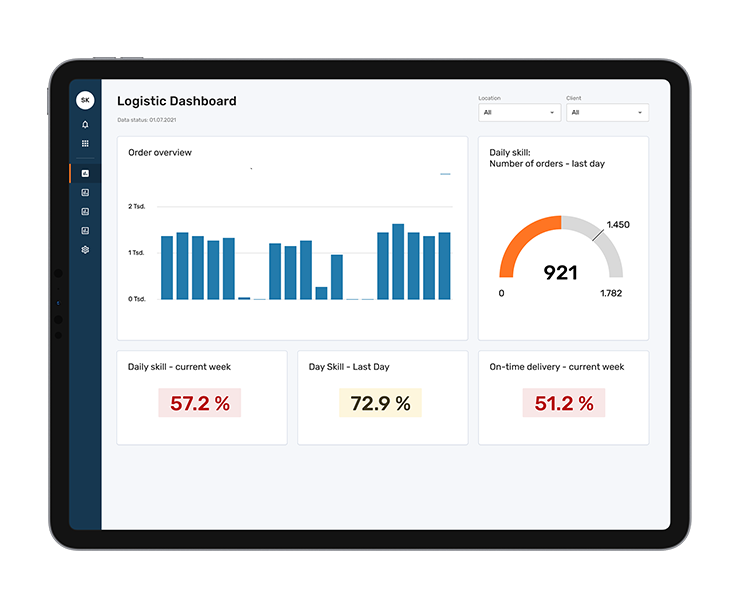As a design guru, the software developer delves into logistics service providers' requirements like no other. He is passionate about exchanging information securely and efficiently and thus speeding up the physical logistics process.


A chain is only as strong as its weakest link – admittedly, an almost overused saying, but there is a lot of truth to it, especially when it comes to supply chains. The strength of a supply chain can be measured by its resilience to crises – and this has been put to the test, especially since the pandemic began with a series of global emergencies. The solution to not being thrown out of the saddle (or off the semi) even in turbulent times: Resilience. With transparent processes, established structures and contingency plans, you can face the unexpected with confidence. Software makes a big contribution to a resistant supply chain and thus makes logistics more resilient – stay tuned for tips and tricks!
Becoming more resilient – easier said than done. If you make an effort in your private life to become a little more resilient and not let the smaller and larger hurdles of everyday life upset you, you often read tips such as “get creative and think in terms of solutions”, “build a stable network”, or “accept what we can't change”. However, these tips can just as easily be applied to logistics: a stable chain of companies in which the various cogwheels mesh efficiently, solution-oriented thinking for moments when something doesn't go according to plan – that works just as well here in logistics.
Basically, resilience in logistics is made up of two important components: On the one hand, it is resistance, but on the other hand, it is also recoverability. If the supply chain is set up flexibly and can respond proactively to expected fluctuations, for example in demand, then it is resilient and therefore not too easily shaken. However, it is at least as important that in the event of an incident (the Corona crisis at the latest showed us that such an incident can always occur), it is able to stabilize as quickly as possible and soon resume functioning at its usual high level of performance. A resilient supply chain is characterized by its ability to cushion any disruptions that may occur and significantly limit their negative impact. At the same time, it should take advantage of modern supply chain technologies to predict and respond quickly to potential opportunities and risks.
Resilience does not mean trying to weather every storm like a tree. Rather, it is about positioning oneself flexibly so as not to be “knocked down” by the volatile movements of the market. Agility is the keyword – like the image of reeds moving with the wind in a storm. Early warning systems and alternative plans are important factors in maintaining this flexibility. Software that supports process monitoring and can thus monitor the success of planned structures is therefore elementary.
For whom are resilient supply chains important? For all actors and companies along the supply chain – after all, a partial failure, no matter how small it may seem, affects everyone. It is similar to the well-known domino effect: All connecting processes are delayed or, in the worst case, even fail completely if a single “stone” does not fall over due to a disruption. This makes it all the more important to ensure transparency and efficient communication along the supply chain. So, take effective systems that monitor planned structures, a track and trace system, reliable forecasting, flexible contingency planning, and add a good dose of data integration for transparent, real-time communication that holds the whole system together. The result: a resilient supply chain! Details follow immediately.

Software (here: EIKONA Power BI Integration) helps, for example, to create meaningful forecasts on delivery reliability
Good planning and transparent process traceability are key to establishing a resilient supply chain. Business intelligence (BI) software and artificial intelligence simulations help to forecast future supply. Potential bottlenecks, which can sometimes set off a whole chain reaction of subsequent delays, can thus be avoided. Efficient work is only possible if all parties involved have real-time information on the whereabouts of the goods at every step of the supply chain. For this purpose, it is not only important to enable track and trace of shipments, but inventories and production capacities should also be communicated transparently. A shipment planning tool is particularly important when planning and controlling complex, multimodal orders. This way, companies can be sure to always use the best logistics route.
How can supply chains be made resilient in the long term?
Software increases the resilience of supply chains and helps to make logistics processes flexible:
The advantages of a resilient supply chain are clear: It can cushion disruptions, is resistant, and recovers as quickly as possible. Those who can react flexibly to the unpredictable remain calm even in the face of the storm – similar to the reeds mentioned above. Transparency and data exchange must be placed at the absolute centre of attention for this purpose. In doing so, one should say goodbye to the idea that everything always runs “like clockwork” – instead, automated adjustments and readjustments are made in real time based on the collected data. Software can do this and makes logistics much more resilient with AI-supported forecasts and modules such as track and trace or shipment planning.